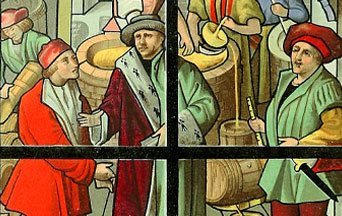
Photo: © Felipe Barandiarán
One of the most enduring myths about the Middle Ages is that the period was not clean. The conditions of the time supposedly did not allow for personal hygiene and sanitation. Most people assume that cleanliness was, at best, reserved for a privileged few.
History does not support this distorted vision. In fact, The Wall Street Journal (Jan. 14-15, 2023) recently published a story in which author Eleanor Janega admitted in the title “The Middles Ages Were Cleaner Than We Think.” Much cleaner, it seems, than even later periods.
Obviously, the technology of the time did not permit developments like modern plumbing. However, the framework for clean living was in place. There was a universal desire to be clean at all levels of medieval society. Indeed, the Middle Ages might be considered the initiator of the quest for cleanliness.
A Religious Decision Based on Virtue
Like most medieval matters, religion played a great role in securing this civilizing achievement. Dr. Janega claims the medievals took to heart the expression that cleanliness is next to godliness. People associated a clean and ordered body with virtue and purity. Impurity and vice were rightly associated with sinfulness and dirtiness.
The most important concern of most individuals was the state of their souls. A person’s interior disposition toward virtue naturally manifested itself exteriorly in the form of cleanliness. When this concern became generalized, society tended toward purity and cleanliness.
Eternal and Natural Law: The Foundation of Morals and Law
Thus, in almost every field of hygiene and personal presentation, medieval people found ways to be clean. Historians have long documented this fact. Writing in the early twentieth century, renowned Belgian historian Godfrey Kurth affirms, “It was the Renaissance, which permitted the habits of cleanliness of the Middle Ages gradually to fall into desuetude, substituting for them a negligence which degenerated into the most repulsive uncleanliness.”
Bathing Widespread
The act of bathing was very widespread at every level in medieval society. Author Nicol Valentin notes, “People of the Middle Ages bathed more than any other era after them until the nineteenth century.”
The methods of washing varied according to the circumstances. A daily wash of some sort was considered indispensable. People resorted to basins, wood tubs, lakes and bathhouses for a full bath. Waters were often infused with herbs and rose petals. Herbal baths and steams were described in manuals like The Saxon Leech Book of Bald, written in early tenth-century England.
Dr. Benega claims, “the emphasis on cleanliness led to a great medieval invention—soap.” While soap-like substances existed in earlier times as medical cleansers, the Middle Ages developed the art of soapmaking for daily hygiene.
Soap makers guilds appeared in Italy as early as the sixth century and spread throughout Europe. Housewives of even the humblest households had their own well-guarded recipes for making soap.
Keeping the Whole Body Pure
In addition to baths with soap, medieval courtesy books contained guidelines for washing hands, face and teeth daily. There was a constant concern that all appeared and smelled fine.
People were encouraged to wash their hands, especially before and after meals. As one advanced up the social scale, the cleansing became more elaborate and ceremonial. Hot, scented water was especially favored.
 Learn All About the Prophecies of Our Lady of Good Success About Our Times
Learn All About the Prophecies of Our Lady of Good Success About Our Times
Tooth powders were developed to keep teeth clean. Hazelwood twigs served as toothbrushes. Medievals used mouthwashes to keep the mouth fresh and attractive.
Finally, it was common to make what today is called a deodorant from hyssop and bay leaves. Aromatic woods, flowers and herbs were also used to keep clothing clean and fresh.
In addition to these practices in society, monasteries observed strict rules about cleanliness. Many had fresh running water and advanced hygiene practices, which later spilled into society.
Two Important Observations
These medieval practices reflected the desire to live a clean and virtuous life. While the systems could have been better technically, they did make much progress in the field.
The motivation for cleanliness was the religious desire for perfection that manifested itself in daily life. Cleanliness was not limited to the higher classes (as in ancient times). An old proverb states, “Cleanliness is the luxury of the poor.”
Thus, all perceived that they could practice cleanliness according to their circumstances in life. This simple practice gave them dignity. However, like virtue, it would require effort and persistence facilitated by a life of grace. The poor imitated the clean customs of society’s natural leaders. The expectation of cleanliness everywhere uplifted all society and gave rise to a wide range of customs, traditions and products reflected in the attractive folk costumes of those times.
Finally, cleanliness was based upon virtue. It reflected the interior of an ordered soul. When the Middle Ages entered into decadence, cleanliness also declined. The Middle Ages were clean because people of that time promoted virtue. There is no better way to explain it.

